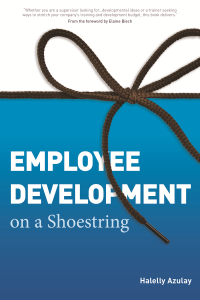Here at Positive Business DC we like to promote books that we think are helpful for creating positive businesses. And one of Gallup’s Q12 (i.e. the 12 things that are the key to having engaged employees) is ‘did you learn something new today?’ Certainly this book can contribute to employee engagement by helping businesses invest in the learning of their employees.
It has been estimated that 70 percent of employee development takes place through informal learning, rather than through formal learning events.  Employee Development on a Shoestring by Halelly Azulay, CEO of TalentGrow, offers insights and lessons for leveraging these naturally occurring growth opportunities in developing employees outside the classroom and ‘outside the box’. This hands-on resource delivers specific implementation tools and techniques for developing motivated, engaged employees in today’s “do more with less” business environment. A handy resource for any employee developer, this book provides worksheets, checklists, and detailed implementation guidelines to help managers develop their workforce in a way that is tailored to each employee’s strengths, development needs, and constraints.
Employee Development on a Shoestring by Halelly Azulay, CEO of TalentGrow, offers insights and lessons for leveraging these naturally occurring growth opportunities in developing employees outside the classroom and ‘outside the box’. This hands-on resource delivers specific implementation tools and techniques for developing motivated, engaged employees in today’s “do more with less” business environment. A handy resource for any employee developer, this book provides worksheets, checklists, and detailed implementation guidelines to help managers develop their workforce in a way that is tailored to each employee’s strengths, development needs, and constraints.
Grounded in employee development best practices, Employee Development on a Shoestring provides in-depth descriptions of the how-to specifics of eleven different, easy to implement employee development methods, including:
- Step-by-step guidance for initial goal-setting and preparation for effective development planning for every employee, for all development methods.
- Templates, worksheets, checklists, and guidelines to make your employee development efforts effective and sustainable.
- A discussion of the value of developing employees in ways that leverage and target their individual strengths, learning styles, and development needs.
- A modular, customized approach to developing employees by tailoring the development method to each employee’s unique needs and each organization’s budget and constraints.
- Ways to capitalize on self-directed learning ideas that are easy to implement and apply, immediately and cheaply.
- Insights for using volunteering as a low-cost and low-effort employee development method.
- Ideas for creating unique immersive learning opportunities by sending employees on a sabbatical.
- How to leverage the power of mentoring to develop new competencies for both mentors and protégés.
- The hidden value of job rotation, stretch assignments, and special teams for addressing your employees’ development needs while enhancing organizational results.
- Ways to multiply your return-on-investment by identifying situations where peer teaching opportunities exist.
- The secret of turning employee development into fun and engaging games and contests.
- Tools and techniques for developing employees by encouraging them to capture stories from the frontlines into digital content for everyone’s benefit.
- Why developing “innovation zones” within your organization may bring huge learning and development rewards.
- An examination of social learning and the use of multiple collaborative online tools for real time, on-the-job employee development.
When we asked Halelly how she connects her work to positive business practices she had this to say:
“Research shows time and again that feeling they are developing new skills and growing their capacity at a job helps people feel engaged and want to stay with the organization. So a positive business practice is to ensure that your people are able to grow in their current role and see how they can expand their skills sets. BlessingWhite’s 2013 Employee Engagement Research Update Report found that ‘When it comes to drivers of engagement, clarity on the organization’s priorities, getting feedback, having opportunities to use skills, and career development remain at the top of the list for a majority of employees.’ BlessingWhite’s Employee Engagement Research Update 01/13 rev2. C http://www.blessingwhite.com/
Also, according to Dan Pink in his book, Drive, one of three key motivators for knowledge workers is developing Mastery, which necessitates lots of practice but also upgrading skills and developing new ones.”
So there you have it. By offering multiple employee development methods for every learning style and budget, experience-based tips and suggestions, exercises, and input on maximizing the utility and efficacy of your employee development efforts, Halelly Azulay has written a comprehensive tutorial for all managers, supervisors, trainers, human resources (HR) personnel, coaches, and other professionals who are involved in developing employee competence efficiently and cost-effectively. Here is a vlog about why she wrote the book: http://www.youtube.com/watch?v=cvzsmwS272w&feature=player_embedded. We hope you’ll check it out.

